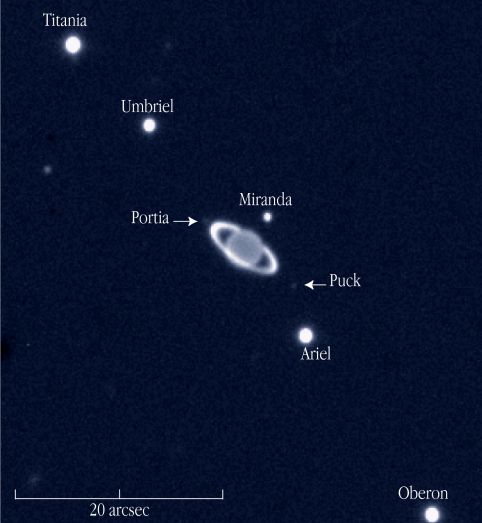Credit & Copyright: E. Lellouch, T. Encrenaz (Obs. Paris),
J. Cuby , A. Jaunsen (ESO-Chile),
VLT Antu,
ESO
Explanation:
Yes it does look like Saturn, but
Saturn is one of only
four
giant
ringed
planets
in our Solar System.
And while Saturn has the brightest rings,
this system of rings and moons actually belongs to
planet Uranus, imaged here
in near-infrared light by the
Antu
telescope at the ESO Parnal Observatory in Chile.
Since
gas
giant Uranus' methane-laced atmosphere absorbs sunlight at
near-infrared wavelengths the planet appears substantially darkened,
improving the contrast between the otherwise relatively
bright planet and the normally faint rings.
In fact, the narrow Uranian rings are
all but impossible to see in visible light with earthbound telescopes
and were discovered only in 1977 as careful astronomers
noticed the then unknown rings blocking light from background stars.
The rings are thought to be younger than 100 million years and
may be formed of debris from the collision of a small moon
with a passing comet or asteroid-like object.
With moons named
for characters in
Shakespeare's plays, the distant
ringed
world Uranus was last visited in 1986 by
the Voyager 2 spacecraft.
1999 2000 2001 2002 2003 2004 2005 2006 2007 2008 2009 2010 2011 2012 2013 2014 2015 2016 2017 2018 2019 2020 2021 2022 2023 2024 2025 |
Январь Февраль Март Апрель Май Июнь Июль Август Сентябрь Октябрь Ноябрь Декабрь |
NASA Web Site Statements, Warnings, and Disclaimers
NASA Official: Jay Norris. Specific rights apply.
A service of: LHEA at NASA / GSFC
& Michigan Tech. U.
|
Публикации с ключевыми словами:
Uranus - rings - Uranus moon - Уран - кольца - спутники Урана
Публикации со словами: Uranus - rings - Uranus moon - Уран - кольца - спутники Урана | |
См. также:
Все публикации на ту же тему >> | |
